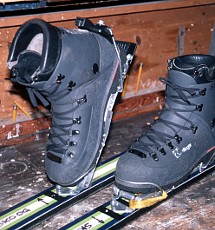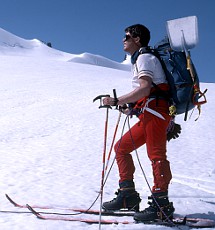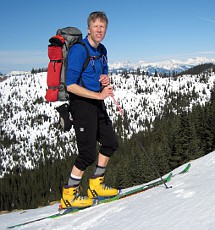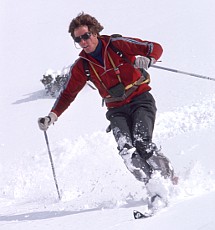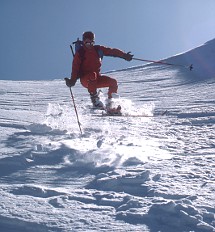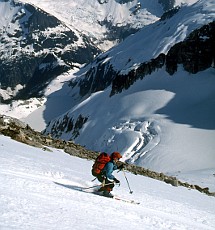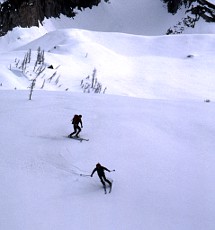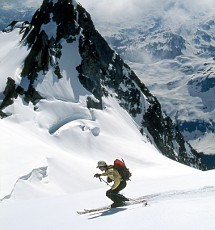 |
|
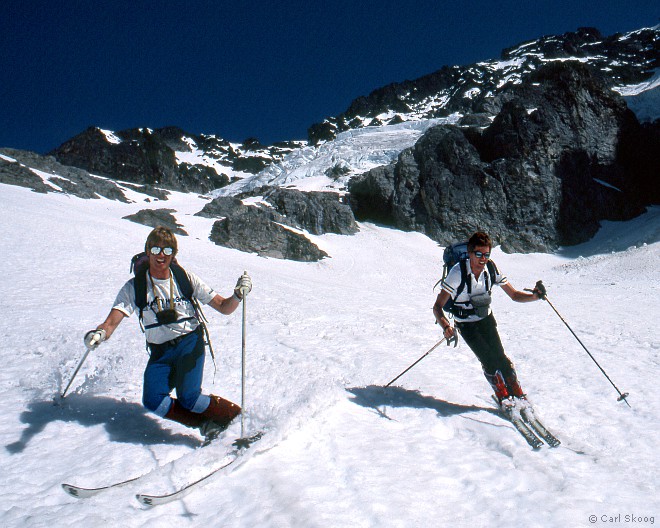 |
|
| Gordy and Lowell Skoog skiing in the North Cascades in May 1986. (Click photos to enlarge.) | |
|
In the late 1970s,
when I started backcountry skiing, most of the young ski tourers I knew were
telemark skiers. Rediscovered by the baby-boom generation, the venerable
old technique of telemarking was new and cool in the 1970s. The simplicity,
light weight, and affordability of telemark gear drew many skiers to the
backcountry for the first time.
Yet several of my closest climbing and skiing friends were alpine skiers. They included Gary Brill, a former ski patroller, Jens Kieler, a ski racer and coach, and my brothers Gordy and Carl. My brothers and I were alpine ski instructors. Gordy was a nationally known freestyle skier and a former member of the K2 Demonstration Team. When we became interested in ski touring, we bucked the trend of our peers and gravitated to alpine touring. In 1979, Gary enticed me I try backcountry skiing by giving me an old pair of strap-on climbing skins. Another friend, Rich Lowell, recommended the new alpine touring bindings developed by Paul Ramer of Colorado. The Ramer binding was light, could be skied in both fixed and free-heel mode, and worked with almost any kind of boot. You could use them with climbing boots for winter and spring mountaineering. The alpine touring boots we read about in the REI catalogs seemed too specialized for the kind of trips we wanted to do. They didn't walk or climb well. And they seemed too expensive, by our standards of the day. So I bought a pair of Ramer bindings and mounted them on a pair of 180 cm K2 skis from Gordy. For boots, I used a pair of Lowa Civettas, full-shank leather boots that I originally bought for ice climbing. Since the boots were not designed for step-in bindings, I made custom toe wires for my Ramers using some steel rod. The toe wire had to fit the boot perfectly to keep the bindings from falling off. I ski toured in those leather boots for five years, including trips such as the Ptarmigan Traverse, Isolation Traverse, and the first winter ascent of Bonanza Peak. Then in 1984, I bought a pair of Kastinger Habeler plastic climbing boots for a trip to Peru. I used plastic climbing boots for multi-day ski trips in the Cascades for the next two decades.
Skiing in climbing boots transports a skier back to the 1960s, at least. The key difference between a climbing boot and a modern ski boot is the lack of lower leg support. Modern ski boots are stiff flexing forward and have no flexibility going backward. Backward stiffness helps the skier recover from mistakes and has played a role in the development of alpine ski technique (for example, "the jet turn"). These advantages are lost in flexible climbing boots. To ski these boots, you need to maintain a perfectly centered stance, leaning neither forward nor backward. The most effective way to do this is by increasing the bend in the ankles. Although the mantra of old-time ski instructors was "bend ze knees," it's better to think of bending the ankles first, then flex the knees to achieve balance over the skis. Wearing a pack shifts the center of gravity backward, so you need to bend the ankles a bit more. The result is a somewhat crouched stance, with the knees soft and reactive. Beyond that, skiing in climbing boots is pretty simple, except you can't use many of the tricks (like driving your weight forward or levering back on the ski tails) that you can use with regular alpine ski boots. Everything must be subtle and centered. This takes some getting used to. In difficult snow, it is sometimes helpful to hop or step the skis to get the turn started. At other times, it may help to bounce during the turn, rythmically flexing the skis to push, push, push them through an arc. With good conditions and a good skier, it can be hard for an observer to tell that climbing boots are being used at all. A key factor in skiing with climbing boots is that you must ski slower. You can't power through obstacles or recover from big mistakes, so you need to slow things down to maintain constant control. In perfect corn snow, it's sometimes reasonable to let the skis rip, but in typical Northwest snow conditions, it's best to slow down. I've never considered climbing boots to be appropriate for skiing terrain where you cannot afford to fall. If you want to ski the really steep stuff, you need real ski boots. I typically have avoided skiing that kind of terrain on my longer trips.
Sometimes my brother Carl and I would link telemark turns on our alpine touring gear. This was mostly done for the sake of a photograph. Ramer bindings can do telemarks, but the toe hinge provides no resistance as you bend the knee, so the feeling is a lot different than real telemark gear. Modern “tech” bindings (such as those made by Dynafit) perform the same way. During the 1980s, Carl experimented with ways to make his climbing boots more supportive. He made some special straps to cinch his boots tighter. One strap had a ‘Y’ arrangement, with webbing going down under the instep and back up around the ankle. Another, independent strap snugged the upper cuff around the leg. The straps had ratchet-style buckles that could be loosened while touring then easily tightened before a descent. These straps made Carl's boots a bit stiffer. We called them “Carlberg straps” after the Arlberg straps used by the old-time Austrians. A photo of the straps is shown above (click to enlarge). In the late 1980s, the first Dynafit alpine touring boots appeared. They were boxy, ill-fitting boots designed for traditional step-in bindings. (Dynafit “tech” bindings didn't appear until the early 1990s.) Dynafit boots were lighter than other alpine touring boots and more supportive than climbing boots, so Carl and I started using them for winter day trips. But we stuck with climbing boots for multi-day spring trips because they were much more comfortable for touring. The years we'd spent skiing in climbing boots had taught us the benefits of backward flex in ski touring boots. Backward flex is the ability to point your toe. This ability lets you lengthen your stride, tour faster with less effort, and it makes touring boots more comfortable. Most alpine touring boots feature a lockable cuff. Until the 2000s, these cuffs never offered as much flexibility as a pair of climbing boots. Paul Ramer recognized the value of backward flex early, writing in 1988, “The single most important feature of an alpine touring boot is backward flex.” Unfortunately, Ramer never made ski touring boots.
During the late 1990s and early 2000s, the “tech” bindings marketed by Dynafit became increasingly popular. Dynafit boots added fittings compatible with these bindings and other boot manufacturers gradually did the same. I delayed switching to tech bindings for years because I was reluctant to give up the ability to use climbing boots for longer trips. I finally made the switch in the early 2000s. Around that time, Dynafit offered a lace-up version of their alpine touring boot called the Mountain Lite or MLT4. I customized these boots by chopping off the rear spoiler for more backward flex and replacing the forefoot lace with a buckle for better control. You can see these yellow boots in one of the photos above. They hiked, toured and skied like climbing boots while taking advantage of the lightest alpine touring bindings available. Since around 2005, equipment advances driven by European randonnee (or “skimo”) racing have rendered climbing boots obsolete for ski touring. It's about time! Boots designed for (or inspired by) randonnee racing are now lighter, stiffer, and if anything, even more nimble in touring mode than any of my old climbing boots. I don't expect to ski in climbing boots again, but it's fun to remember the role they played in my earlier life as a backcountry skier. Climbing boots carried me hundreds of miles and thousands of vertical feet during a time when relatively few backcountry skiers were venturing deep into the Cascades and Olympics. Climbing boots were my friends in high places. —Lowell Skoog
|
||||||||||||||||||||||||||||
| The Alpenglow Gallery |
